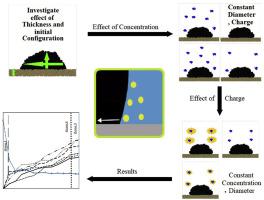Journal of Petroleum Science and Engineering Pub Date : 2020-08-03 , DOI: 10.1016/j.petrol.2020.107724 Jamal Salehzadeh Yekshaveh , Arezou Jafari , Zahra Tohidi , Reza Pour Salehi

|
The real mechanisms beyond the effect of nanoparticles on oil phase displacement by water are still not completely understood. So, in this research, the simultaneous effects of charge and concentration of silica nanoparticles on the oil droplet detachment from calcite surface has been investigated for the first time. For this aim, the parameters of oil droplet contact angle, oil Center Of Mass, Mean Square Displacement and viscosity of water phase have been studied by using molecular dynamics simulation. The thickness of 15°A is selected for all simulations after checking the thickness effect on contact angle results. It was declared that initial shape of oil droplet affected on final contact angle slightly with the relative error of 0.7%. According to the results, silica nanoparticles can lift the oil droplet from the edges because of their interactions with rock surface and water viscosity enhancement which leads to intensify viscous forces and wettability alteration toward more water wet state. In addition, and there is an optimum concentration which decreases with nanoparticle charge rising. In neutral system, the most contact angle alteration occurs in presence of 14 nanoparticles. While the amount of optimum concentration decreased with the growth of nanoparticle's charge and reached to 4 nanoparticles at charge of 0.4 electrons. In addition, there is an optimum charge and it is 0.4e for nanoparticles. The state of rock wettability depends on nanoparticle properties such as charge, size and concentration and this lets us to design a nanoparticle with best performance and least cost.
中文翻译:

油-水-纳米二氧化硅-岩石系统的纳米级模拟:使用带电纳米粒子的润湿性和流变性质改变
除了纳米颗粒对水的油相置换的影响之外,真正的机理仍然不完全清楚。因此,在本研究中,首次研究了二氧化硅纳米粒子的电荷和浓度对方解石表面油滴分离的同时影响。为此,通过分子动力学模拟研究了油滴接触角,油质心,均方位移和水相粘度等参数。厚度15 °A在检查了厚度对接触角结果的影响后,将所有模拟选择为。宣称油滴的初始形状对最终接触角的影响很小,相对误差为0.7%。根据结果,由于二氧化硅纳米颗粒与岩石表面的相互作用和水的粘度增加,二氧化硅纳米颗粒可以从边缘提起油滴,这导致粘性力增强,并且向更多水润湿状态的润湿性改变。另外,存在随着纳米粒子电荷的增加而降低的最佳浓度。在中性系统中,最大接触角变化发生在14个纳米粒子的存在下。而最佳浓度随纳米粒子电荷的增长而降低,并以0.4个电子电荷达到4个纳米粒子。此外,有一个最佳电荷,对于纳米粒子为0.4e。岩石的润湿性状态取决于纳米粒子的性质,例如电荷,尺寸和浓度,这使我们能够设计性能最佳,成本最低的纳米粒子。










































 京公网安备 11010802027423号
京公网安备 11010802027423号